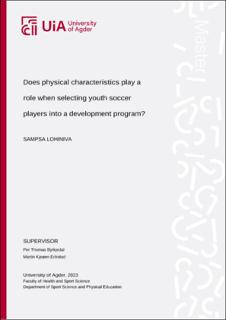| dc.description.abstract | BACKGROUND: Soccer is a complex sport that require scouts and coaches to assess a number of physical characteristics when selecting players to developmental systems. The aim of this study was to compare physiological test performance characteristics of players selected into a Norwegian talent developing program (selected) with their equal peers (non-selected).
METHODS: Ninety-six soccer players divided into groups of selected and non-selected (selected girls: n = 14, mean age 14.8 ± 0.2 years; non-selected girls: n =18, mean age 15.5 ± 0.6 years; selected boys: n = 16, mean age 14.7 ± 0.3 years; non-selected boys: n = 48, mean age 14.7 ± 0.3 years) were tested for 10-, 20-, 30-m linear sprint, velocity m/s, change of direction (COD) dominant and non-dominant, and countermovement jump (CMJ) in an indoor laboratory.
RESULTS: Independent t-test and Cohen’s effect sizes (ES) were used to compare means. Group comparisons revealed trivial to large ES for 10-, 20-, 30-m sprint, velocity, CMJ, and COD dominant, and non-dominant were (0.15; -0.42; -0.35; 0.06; -0.57; -0.64; -0.43), respectively, for girls and (-0.93; -0,80; -1.04; 1.24; 0.51; -0.79; -0.78), respectively, for boys. However, only 30-m sprint and velocity showed significant difference between selected and non-selected boys.
CONCLUSION: Although a tendency towards better physical performance is evident in the selected players of both genders, only 30-sprint and running velocity seems to be a discriminative attribute between selected and non-selected boys. A plausible explanation for better results in selected players might be increased exposure to systematic training.
KEYWORDS: Soccer, Talent identification, Sprint, Change of direction, Countermovement jump, Physical performance testing | |
